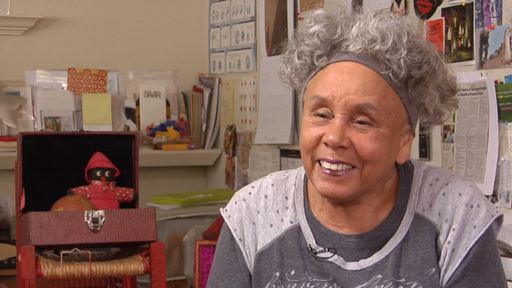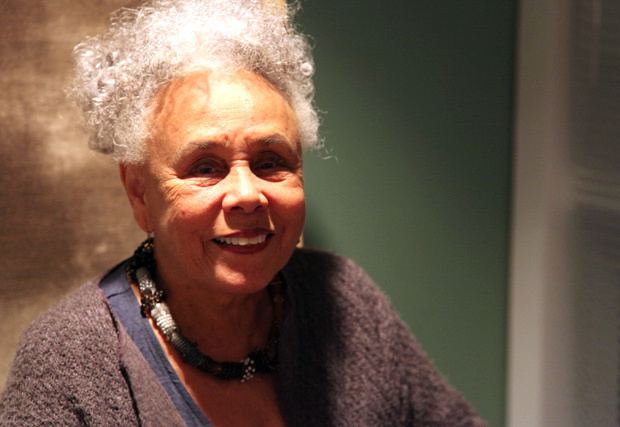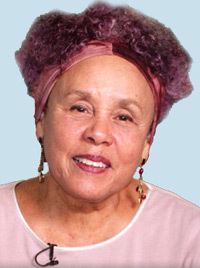Nationality American Name Betye Saar | Role Artist | |
 | ||
Born July 30, 1926 (age 99) ( 1926-07-30 ) Los Angeles, California Awards Guggenheim Fellowship for Creative Arts, US & Canada Education California State University, Long Beach (1958–1962), University of California, Los Angeles (1949) Similar People Alison Saar, Faith Ringgold, Lowery Stokes Sims | ||
Meet betye saar artist artistic evolution
Betye saar interview
I. Introduction

Betye Irene Saar (born July 30, 1926 in Los Angeles, California) is an American artist known for her work in the medium of assemblage, but is also a visual storyteller and an accomplished printmaker.[1] Saar was a part of the Black Arts Movement in the 1970s, which engaged myths and stereotypes about race and femininity. Her work is considered highly political, as she challenged negative ideas about African-Americans throughout her career.
Contents
- Meet betye saar artist artistic evolution
- Betye saar interview
- I Introduction
- II Personal life
- Early Work
- The Liberation of Aunt Jemima
- Assemblage and Installation
- IV Artist Statement
- Excerpt from Saar Migrations and Transformations
- V Political Activism
- VI Education
- VII Selected solo exhibitions
- VIII Awards and honors
- IX Selected collections
- References
II. Personal life

Born Betye Irene Brown to Jefferson Maze Brown and Beatrice Lillian Parson in 1926, Saar spent her early years in Los Angeles.[4] After her father's death in 1931, Saar and her mother, brother, and sister moved in with her maternal great-aunt Hattie Parson Keys in Pasadena, California.[5] Her college education began with art classes at Pasadena City College[6] and continued at the University of California, Los Angeles, where she received a B.A. in design in 1949.[7] She went on to graduate studies at California State University, Long Beach, University of Southern California, California State University, Northridge, and American Film Institute.[8]

After graduating in 1949, Saar became a social worker in addition to pursuing art. A business partnership with enamel jewelry artist Curtis Tann brought her into Tann's circle of black artist friends and patrons. In the course of their business, they entered state fairs and community art competitions, one of which led to meeting her future husband, combat artist and plein air painter Richard Saar, whom she married in 1952. Shortly after, she quit her job as a social worker and set up a small home studio in her Los Angeles, where she created enamel jewelry and designed greeting cards. During this period she gave birth to two children, mixed media artist Lezley Saar in 1953 and Alison Saar who worked in sculpture and installation in 1956.[9] Her son Tracey is a writer.
Early Work

Saar began her graduate education in 1958, originally working towards a career in teaching design.[10] However, a printmaking class she took as an elective changed the direction of her artistic interests.[9] She credited printmaking as her "segue from design into fine arts."[11]
Saar was inspired to create assemblages by a 1967 exhibition by found object sculptor, Joseph Cornell.[12] She was also greatly influenced by Simon Rodia's Watts Towers, which she witnessed being built in her childhood.[13] Saar said that she was “fascinated by the materials that Simon Rodia used, the broken dishes, sea shells, rusty tools, even corn cobs -- all pressed into cement to create spires. To me, they were magical.” (migrations and transformations)
She began to create work that consisted of found objects arranged within boxes or windows, with items that drew from various cultures to reflect her own mixed ancestry: African-American, Irish, and Native American.[13]
The Liberation of Aunt Jemima
In the 1960s, Saar began collecting images of Aunt Jemima, Uncle Tom, Little Black Sambo, and other stereotyped African-American figures[14] from folk culture and advertising of the Jim Crow era. She incorporated them into collages and assemblages, transforming them into statements of political and social protest.[15] The Liberation of Aunt Jemima is one of her most notable works from this era. In this mixed-media assemblage, Saar utilized the stereotypical mammy figure of Aunt Jemima to subvert traditional notions of race and gender.[16] Mammy is the most well known racial caricature of African American women, created during the era of American slavery as manufactured evidence that black slave women were content and even happy to be slaves, and thus, that slavery was a humane institution. Aunt Jemima is arguably the most famous and successful Mammy image, created in 1889 by a Missouri newspaper editor and mill owner to promote self-rising flour that only needed water. (historyonthenet)
“It’s like they abolished slavery but they kept black people in the kitchen as Mammy jars,” Saar says of what drove her to make the piece. “I had this Aunt Jemima, and I wanted to put a rifle and a grenade under her skirts. I wanted to empower her. I wanted to make her a warrior. I wanted people to know that black people wouldn’t be enslaved by that.” (LA Times)
Saar’s assemblage is laid inside of a shoebox-sized frame, plastered with Aunt Jemima advertisements. A caricatured sculpture of Aunt Jemima presents a notepad with a photograph of a Mammy with a white baby depicted. The Aunt Jemima sculpture holds a broom in one hand and a rifle in the other, subverting her happy servant and caregiver stereotype by way of a militant alter ego who demands her own agency and power. A large, clenched fist, echoing the black power symbol, is collaged over and partially obscuring the Mammy photograph, recognizing the aggressive and radical means used by African American activists in the 1970s to fight for their rights. Aunt Jemima is liberated through transformation from a racist domestic caricature into an image of black power. (art history of the day)
Assemblage and Installation
Betye Saar’s lifelong habit of scouring flea markets and yard sales deepened her exposure to the many racial stereotypes and demeaning depictions of blacks to be found among the artifacts of American commercial and consumer culture, such as advertisements, marketing materials, knickknacks, sheet music, and toys. In 1969 Saar first introduced these materials into her work. Three years later, she produced a series of more than twenty pieces that, in her own words, “exploded the myth” of such imagery, beginning with her seminal portrait of Aunt Jemima.
Saar’s work with racial imagery and stereotypes is not only to be found, however, in the tumultuous era of the civil rights movement. She revisits the theme again in her series Workers + Warriors, The Return of Aunt Jemima from 1998 and in the series In Service, a Version of Survival from two years later, in each case doing so in part to remind her viewers that racism continues to be a major factor in American society. Adopting stereotypical images of blacks- among them mammies, sambos, and Uncle Toms- which proliferated in early- to mid-twentieth-century popular culture, Saar reclaims these painful symbols and endows them with dignity, power, and energy.
Excerpt from Saar, Migrations and Transformations
In the 1970s, Saar moved on to explore ritual and tribal objects from Africa as well as items from African-American folk traditions. In boxed assemblages, she combined shamanistic tribal fetishes with images and objects intended to evoke the magical and the mystical.[17] When her great-aunt died in 1974,[18] Saar acquired family memorabilia and created a series of more personal and intimate assemblages that incorporated nostalgic mementos of her great-aunt's life. She arranged old photographs, letters, lockets, dried flowers, and handkerchiefs in shrine-like boxes to suggest memory, loss, and the passage of time. This became a body of work she referred to as her "nostalgic series."[19]
In the early 1980s, Saar taught in Los Angeles at the University of California and the Otis Art Institute. In her own work she approached a larger, room-sized scale, and created site-specific installations. These included altar-like shrines exploring the relationship between technology and spirituality, and incorporated her interests in mysticism and Voodoo. Through the pairing of computer chips with mystical amulets and charms, these monumental constructions suggested the need for an alliance of both systems of knowledge: the technical and the spiritual.
Today, Saar continues to live and work in Los Angeles, working primarily in found object sculpture.[22] She has been awarded honorary doctorate degrees by California College of Arts and Crafts, California Institute of the Arts, Massachusetts College of Art, Otis College of Art and Design, and San Francisco Art Institute.[23]
IV. Artist Statement
Betye Saar, Extending the frozen moment
“When I was a child, I loved looking through my great-aunt Hattie’s album filled with photographs of family and friends from Kansas City, Missouri. As Hattie and my mother recalled events and people, they exchanged stories and memories of their shared past. This experience made me realize that every picture tells a story.
In the early 1960s, when I began to collect images depicting derogatory stereotypes of African Americans, I would often find photographs. Once while sorting through a box of photographs in a dusty thrift store in Pasadena, I discovered a wonderful photograph of two African American children, a young boy standing beside a baby. There was something haunting about the image. Later, in the 1970s, I used that photo in the assemblage box “Gone Are the Days.”
When the camera clicks, that moment is unrecoverable. It is gone yet remains, frozen in time and space on a piece of paper. The photograph can reveal many things-the setting, the people, what they are doing, what they are wearing-and yet it still has secrets. There is a mystery with clues to a lost reality.
When a photo triggers something in me - my imagination perhaps - I feel that I am offered a chance to reinterpret the visual image, or I am inspired to create an alternative reality by integrating the photo with other media, materials, and objects. The process becomes a sort of unraveling of the mystery and a piecing together of forgotten lives, a process that somehow extends the frozen moment.”
Excerpt from Saar, Migrations and Transformations
“I have always been a collector. As a child, I saw the Watts towers being constructed and was fascinated by the materials that Simon Rodia used, the broken dishes, sea shells, rusty tools, every corn cobs- all pressed into cement to create spires. To me, they were magical."
I have always been attracted to places of beauty and mystery, both natural and man-made. My travels have taken me to every continent (except the Arctic and Antarctic.) I seek out ancient and exotic places.
As I have explored cities, villages, museums, churches, shrines, temples, lakes, rivers, deserts and mountains, I have collected sights, sounds, smells, tastes, impressions and emotions.
I have stood on the Great Wall of China and sailed up the Yangzee RIver.
I have paused in the shadow of the Pyramids and waded in the Nile.
I have flown over the icefields in Alaska and heard the white thunder of those glaciers.
I have gazed at the Southern Cross in New Zealand’s midnight sky and crossed over the Great Divide in Canada.
I have shivered in the dark, dank slave holding cells above the seas in Nigeria and walked silently through the slave quarters of an abandoned plantation in South Carolina.
From all of these places and beyond, I have collected goods- objects, photographs, souvenirs and shards.
I have gathered from the narrow alleys of Marrakesh, Port-au-Prince and Macau to the dusty shops of Belgium, France and Italy; from the market stalls in Brazil, China and Senegal to the antique stores, second hand shops, and swap meets in the North, South, East, West, and Center of America.
Remnants of journeys- tangible and intangible- are stored. When I begin to select materials to create an art object, my stream-of-consciousness is activated. Threads from my memory start to weave and blend and I recall the essence of each object- the “where” and “when” I found them.
With hand, head and heart, I manipulate them until they are recycled and reborn into Art.
V. Political Activism
In the late 1960s, her focus turned to the civil rights movement and issues of race.
“My purpose in creating these works is to remind us about the struggle of African Americans and to reclaim the humiliating images of how these workers were once portrayed. I feel that, however painful, there is honor in re-presenting the past. Racism should neither be ignored nor sanitized, as it is a form of bondage for everyone, regardless of color. Racism cannot be conquered until it is confronted.” (Racial Imagery and Stereotypes (Excerpt from Saar, Migrations and Transformations
Black women artists like Faith Ringgold, Betye Saar, Adrian Piper, Howardena Pindell, and Barbara Chase-Riboud explored the African-American identities and actively rejected art world racism, while simultaneously being drawn to the cause of women’s liberation.
Saar, in her artistic journey through various artistic and activist communities from black nationalist to black feminist and womanist, maintained a “mobile of identity” that permitted her to interact freely with each group. Saar met with other black women artists at Suzanne Jackson’s Gallery 32 in 1970. The resulting group show was titled Sapphire (You’ve Come a Long Way, Baby). This was likely the first contemporary African American women’s exhibition in California, and included watercolorist Sue Irons, printmaker Yvonne Cole Meo, mixed media artist Suzanne Jackson, pop artist Eileen Abdulrashid, and Saar. (Carpenter)
In the 1970s, as the Black Power movement was ascendant, she observed it in her art, as she increasingly employed symbols tied to the African American struggle, from the cruel schematics of slave ships to the hackneyed images of black memorabilia she’d begun collecting.
“If you are a mom with three kids, you can’t go to a march,” says Saar, “but you can make work that deals with your anger. (LA Times)
When asked about the politics behind her art in a 2015 interview with writer Shelley Leopold,[21] Saar stated, "I don't know how politics can be avoided. If you happen to be a young Black male, your parents are terrified that you're going to be arrested -- if they hang out with a friend, are they going to be considered a gang? That kind of fear is one you have to pay attention to. It's not comfortable living in the United States. I'm born in Los Angeles, with middle class parents and so I never really had to be in a situation that tense. My grandmother lived in Watts and it's still really poor down there. People just do the best they can." “continue the original quote from the Wikipedia article here - it’s beautiful” - Sarah
VI. Education
She has been awarded honorary doctorate degrees by California College of Arts and Crafts, California Institute of the Arts, Massachusetts College of Art, Otis College of Art and Design, and San Francisco Art Institute.[23]
